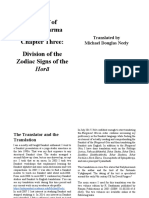Ashtakavarga - An Introduction: (Published in The E-Zine - Astro Vision Magazine of Aug. 2008 Issue)
Ashtakavarga - An Introduction: (Published in The E-Zine - Astro Vision Magazine of Aug. 2008 Issue)
Uploaded by
توني إيرانCopyright:
Available Formats
Ashtakavarga - An Introduction: (Published in The E-Zine - Astro Vision Magazine of Aug. 2008 Issue)
Ashtakavarga - An Introduction: (Published in The E-Zine - Astro Vision Magazine of Aug. 2008 Issue)
Uploaded by
توني إيرانOriginal Title
Copyright
Available Formats
Share this document
Did you find this document useful?
Is this content inappropriate?
Copyright:
Available Formats
Ashtakavarga - An Introduction: (Published in The E-Zine - Astro Vision Magazine of Aug. 2008 Issue)
Ashtakavarga - An Introduction: (Published in The E-Zine - Astro Vision Magazine of Aug. 2008 Issue)
Uploaded by
توني إيرانCopyright:
Available Formats
Ashtakavarga By yenbeeyes
Ashtakavarga an Introduction
(Published in the E-zine Astro Vision magazine of Aug. 2008 issue)
Maharishi Parasara states in his magnum Opus Brihat Parasara Hora Shastra, There are two divisions, or parts of the Jyotisha Shastra, namely general and particular. I have already dealt with the general part. I now come to the other part, which deals with this subject in particular. Thereafter he goes on explaining the effects of the 12 houses and the 7 planets in chapters 66 to 72. In Kaliyuga, minds of the people have become blunt because of the sinful deeds committed by them. This shastra according to Parasara is for the benefit of all. In this shastra or system, there will be no contradictions in judging the effects of happiness and sorrows and for determination of longevity. Varahamihira in his Brihat Jataka mentions Ashtakavarga in a casual manner as it is was commonplace in his times. It is quite possible it might have become an integral part of the main body of astrological teachings and probably he has not given many details about the system. This Shastra or System is called as ASHTAKAVARGA. Ashta means eight and varga means division. It is a System by which strength of planets are ascertained. Primarily intended to be used in transit (Gochara) analysis, it also finds use in natal chart interpretation. Only 7 planets and Lagna are included in this system. Rahu and Ketu are excluded. Out of my experience, I can very confidently say that Ashtakavarga System is one of the most efficient systems within Jyotish and I have found it extremely useful for timing of events. In addition, transit effects studied with the help of this system present an accurate picture of the coming events. When Applied with Vimsottari dasa system, Ashtakavarga can give extremely clear picture of the way in which events are likely to unfold. However according to Prof. B.V.Raman As far as the determination of longevity is concerned, the Ashtakavarga System cannot be solely relied upon for accuracy. He is of the opinion that the failure of the system with regard to longevity might be due
Ashtakavarga By yenbeeyes to either inadequate comprehension of the principles or the inadequacy of the number of examples worked out. A very simple explanation of Ashtakavarga: It is a method of calculating the powers of the 7 planets (excluding Rahu and Ketu) and of Lagna on one another. Thus it provides a means of examining the influences of the 7 planets and of Lagna depending on their locations in a horoscope, on each other and all the 12 houses in a horoscope. In other words, each planet from Sun to Saturn receives a contribution from 8 indicators (7 planets and Lagna) depending on their placement in the chart. As the famous work Horamakaranda says as a result of the progression of the 7 planets from their respective radical places and from Lagna, a collective factor sets in going under the name of Ashtakavarga. It is likely that in a horoscope, a planet say Jupiter is capable of emitting beams that may influence certain places declared as favourable, both from his position in the chart as well as from the positions of other planets. The System can be used in all divisional charts along with Chaleta Bhava charts and even Horary Astrology. Prasna Marga also has got a chapter on Ashtakavarga. Casting the Ashtakavarga Charts: The various Ashtakavarga Charts that are in use are: 1. 2. 3. 4. Bhinnashtakavarga or Individual Ashtakavarga charts. Bhinnasktakavarga after reduction Sarvashtakavarga or Total Ashtakavarga chart Prasthara or spread-out Ashtakavarga chart.
I am not going to explain the procedures for making the above charts in this article, as majority of the current day Astrological softwares do contain these calculations. To know about how these are calculated readers can go through Dr. B.V.Ramans book Ashtakavarga System of Prediction. To calculate them manually much effort is needed and hence probably this system was discarded. However, I will give glimpse of the method of calculation for one planet say Sun. Calculating Suns Ashtakavarga:
Ashtakavarga By yenbeeyes Each planet has got an influence on each sign. If it is benefic influence it is called bindu and if it is malefic it is called rekha. The benefic as well as the malefic places have already been given in BPHS. Suns benefic places are the 1st, 2nd, 4th, 7th, 8th, 9th, 10th and 11th from himself. The same places are benefic fro Mars and Saturn too. The 5th, 6th, 9th and 11th from Jupiter; the 3rd, 6th, 10th and 11th from the Moon; the 3rd, 5th, 6th, 9th, 10th, 11th and 12th from Mercury; the 3rd, 4th, 6th, 10th, 11th and 12th from the Lagna and the 6th, 7th and 12th from Venus are the benefic places. The rest are malefic places. If it is drawn into a table it will look like this: (The 1st column position represents the individual planet's natal position in the chart)
from the SUN MOON MARS MERCURY JUPITER VENUS SATURN LAGNA
1 * *
2 *
3 *
4 *
6 *
7 * *
8 * *
9 * * * * *
10 * * * *
11 * * * * * * *
12
* *
* * * * * * * * *
* *
* *
* *
* *
Instead of dots a star has been placed. The total of 48 points in contributed by Sun. In a similar manner each planet distributes benefic points. Moon contributes 49 points, Mars 39, Mercury 54 points, Jupiter 56 points, Venus 52 points and Saturn 39 points making a total of 337 points. Here I wish to bring to the knowledge of readers that there are 2 major variations for calculating the benefic (or malefic) points or bindus from a given planet-One of Parasara and the other of Varahamihira. The difference between the two lies in the vargas of Moon and Venus and results in a couple of points (however the total remains 337 in both systems). The difference is so minute and hence it becomes difficult to judge which of the two systems is better. If the software provides for both the systems, readers can verify this point. The specific differences between the two systems are: a) Jupiters contribution in Moons Ashtakavarga: Parasara: Benefic places are 1st, 2nd, 4th, 7th, 8th, 10th and 11th from natal Jupiter.
Ashtakavarga By yenbeeyes Varahamihira: Benefic places are 1st, 4th, 7th, 8th, 10th, 11th and 12th from natal Jupiter. b) Mars contribution in Venus Ashtakavarga: Parasara: 3rd, 4th, 6th, 8th, 11th and 12th from natal Mars are benefic places. Varahamihira: 3rd, 5th, 6th, 9th, 11th and 12th from natal Mars are the benefic places. Thus the combined or collective ashtakavarga of the Sun and all the other 6 planets are calculated. By adding together the bindus contained in each of the signs the Sarvashtakavarga is drawn. If readers are desirous of knowing in detail the method of calculation of Bhinnashtakavarga as well as Sarvashtakavarga, I shall send a detailed article making the calculation clear through an Example chart. This is in general about the Regular Ashtakavarga System. The purpose of this article is to introduce you to one unique Ashtakavarga System called KAS when expanded becomes Krushnas Ashtakavarga System. Some of the readers might already be a member of the following Yahoo groups which are purely dedicated to KAS: http://groups.yahoo.com/group/astrologyandtimingevents/ http://groups.yahoo.com/group/kas_pravin/ The Web sites dedicated to this unique system are: http://krushna.sageasita.com www.ashtro.ca Readers may visit the above links and learn more about this system.
You might also like
- The Determination of Longevity (Ayu Nirnay)Document1 pageThe Determination of Longevity (Ayu Nirnay)AyushiNo ratings yet
- Karaka As Used in JaiminiDocument2 pagesKaraka As Used in JaiminiAanandita Rao100% (1)
- Panchang Report: Donald TrumpDocument7 pagesPanchang Report: Donald TrumpNikhitha Vaishnavi Thalapaneni100% (1)
- LagnaDocument2 pagesLagnaSree RajaRajeshwari PeetamNo ratings yet
- Graha Uchcha Neech-126705Document2 pagesGraha Uchcha Neech-126705Puppa ScoopaNo ratings yet
- Advanced Astrology Chart - Part 1Document11 pagesAdvanced Astrology Chart - Part 1BC AmrathaNo ratings yet
- AshtakaVarga Audio LessonDocument4 pagesAshtakaVarga Audio Lessonnabin shresthaNo ratings yet
- Astrology and LesbianDocument1 pageAstrology and LesbianRohit Jivani GuruNo ratings yet
- File To CheckDocument8 pagesFile To CheckakathrechaNo ratings yet
- Yogni DasaDocument39 pagesYogni DasaCcmm KkkNo ratings yet
- Mangal Dosha - Kuja Dosha Calculator - Manglik Dosha FinderDocument3 pagesMangal Dosha - Kuja Dosha Calculator - Manglik Dosha Findersimpleguy8147No ratings yet
- Jyotish - 2017 - RS Chillar - Principles and Techniques For Prediction - HousesDocument373 pagesJyotish - 2017 - RS Chillar - Principles and Techniques For Prediction - HousesDinesh GNo ratings yet
- Jnotes 50 Menstrual-MiscarriageDocument7 pagesJnotes 50 Menstrual-MiscarriageGauravGuptaNo ratings yet
- Prominent HouseDocument2 pagesProminent HouseMeenakshi BangarNo ratings yet
- Varahamihira - Blogspot.in-Praśna IV Use of Prasna ArudhaDocument3 pagesVarahamihira - Blogspot.in-Praśna IV Use of Prasna ArudhasubramanyaNo ratings yet
- DefinitionDocument3 pagesDefinitionJyothi VadhirajNo ratings yet
- Balarisht... : By: Mrs. ABHA Sharma Senior Researcher B.V.B. DelhiDocument6 pagesBalarisht... : By: Mrs. ABHA Sharma Senior Researcher B.V.B. Delhiindians jonesNo ratings yet
- Ashtak VargDocument7 pagesAshtak VargpriteshbamaniaNo ratings yet
- How To Read HoroscopeDocument1 pageHow To Read HoroscopeexpertjatakNo ratings yet
- Pitfalls of Mundane Astrology by Gary Gomes Edited by Vinayak Bhatt 30th Jan 2023Document6 pagesPitfalls of Mundane Astrology by Gary Gomes Edited by Vinayak Bhatt 30th Jan 2023Suniil JohnNo ratings yet
- Importance of Divisional Charts in Vedic AstrologDocument10 pagesImportance of Divisional Charts in Vedic Astrologanimesh dasNo ratings yet
- Calc Ascendant (A)Document9 pagesCalc Ascendant (A)indians jonesNo ratings yet
- New Microsoft Office Word DocumentDocument7 pagesNew Microsoft Office Word DocumentdakshinastrologerNo ratings yet
- Pending KarmaDocument1 pagePending KarmaSharad Sharma0% (1)
- 22 KochDocument3 pages22 KochLydia GeorgetaNo ratings yet
- Astrological InheritanceDocument10 pagesAstrological Inheritancesarvadu100% (1)
- Nadi SecDocument16 pagesNadi Secsudins00100% (1)
- Hora Sara: Chapter-12. The Effects of Budha DashaDocument26 pagesHora Sara: Chapter-12. The Effects of Budha DasharaokvkpNo ratings yet
- Vedic Astro 2013 05Document39 pagesVedic Astro 2013 05ramapvkNo ratings yet
- Varahamihira - Strength of Planets - The Shadbala - IDocument1 pageVarahamihira - Strength of Planets - The Shadbala - ISubramanya RaoNo ratings yet
- AshtakavargaDocument2 pagesAshtakavargamechnicalstudentNo ratings yet
- 1-Ārambha - 6-Nak Atra - BAVA - 4-Nak Atra, Special FeaturesDocument11 pages1-Ārambha - 6-Nak Atra - BAVA - 4-Nak Atra, Special FeaturesKaran ChadhaNo ratings yet
- Tarabala and Chandrabala in MuhurtaDocument4 pagesTarabala and Chandrabala in MuhurtaKumar SNo ratings yet
- 1-Ārambha - 6-Nak Atra - 1-Nak Atra Moon SignsDocument19 pages1-Ārambha - 6-Nak Atra - 1-Nak Atra Moon SignsKaran ChadhaNo ratings yet
- B S RaoDocument95 pagesB S Raojanakrajchauhan100% (1)
- Sun PindayurdayaDocument25 pagesSun PindayurdayaAnonymous TWzli5No ratings yet
- Vedic Astrology Lesson - 3: The Anticlockwise Solar SystemDocument3 pagesVedic Astrology Lesson - 3: The Anticlockwise Solar SystemNagendra KrishnamurthyNo ratings yet
- Bhavakarakas VVVgoodDocument3 pagesBhavakarakas VVVgoodKrishna CHNo ratings yet
- Point Based Kuta: Wednesday, October 06, 2004Document34 pagesPoint Based Kuta: Wednesday, October 06, 2004prasadNo ratings yet
- Bhrigu AstrologyDocument5 pagesBhrigu Astrologyज्योतिष आचार्याNo ratings yet
- Effects of CombustionsDocument1 pageEffects of CombustionsSachin MakhijaNo ratings yet
- Shodash VargasDocument2 pagesShodash VargasVinay BajrangiNo ratings yet
- Jyothisha Prakaasham Mesha - VijayaDocument46 pagesJyothisha Prakaasham Mesha - VijayaAnonymous 5mSMeP2jNo ratings yet
- Chapter 2: Fundamental Principles: KP Learning Home TutorialDocument21 pagesChapter 2: Fundamental Principles: KP Learning Home TutorialShanmugam GobinathNo ratings yet
- Astrology Basic - 1Document3 pagesAstrology Basic - 1abhinay anandNo ratings yet
- The Atmakaraka - (C) Sarajit Poddar - 22july2023Document7 pagesThe Atmakaraka - (C) Sarajit Poddar - 22july2023Pushyamitra ShungaNo ratings yet
- TP AnalysisDocument6 pagesTP Analysiskp_mk2640No ratings yet
- Sangyan Tattwa - संज्ञान means Information, Knowledge, Proper KnowledgeDocument11 pagesSangyan Tattwa - संज्ञान means Information, Knowledge, Proper KnowledgeRavi GoyalNo ratings yet
- Descartes, Rene - The Principles of PhilosophyDocument5 pagesDescartes, Rene - The Principles of PhilosophyUmashankar Gounder100% (1)
- Ketu MarsDocument1 pageKetu Marsf_factor100% (2)
- Drekkana RokDocument12 pagesDrekkana RokPrasad EdeNo ratings yet
- Saravali of Kalyaavarma Chapter Three DDocument75 pagesSaravali of Kalyaavarma Chapter Three DdattapadwalNo ratings yet
- Lesson 18: Blind Chart Analysis ABA-7Document3 pagesLesson 18: Blind Chart Analysis ABA-7Subramaniam Raju KrishnanNo ratings yet
- Planets in Houses FromDocument1 pagePlanets in Houses FromSatyanarayana Naik100% (1)
- KP Ezine June 2014Document32 pagesKP Ezine June 2014anand_kpm100% (1)
- Sreeastropont - Blogspot.in-Basics of Jaimini AstrologyDocument2 pagesSreeastropont - Blogspot.in-Basics of Jaimini AstrologysubramanyaNo ratings yet
- Benazir Bhutto Search of Correct Chart PDFDocument4 pagesBenazir Bhutto Search of Correct Chart PDFbhatambarekar100% (1)
- Horoscope MatchingDocument11 pagesHoroscope Matchingsamm123456No ratings yet
- Sex of Child - KP SystemDocument2 pagesSex of Child - KP SystemRavindraNo ratings yet



























































